Horses have many different varieties of colors. Some are much more popular than others. Bay, black, chestnut, white, grey, paint, and some appaloosa colors are all quite well known. Today, though I will show you some not-so-popular colors that I find fascinating.
This is Champagne. It is restively a new known color to the horse world. Champagnes are characteristic to the pink muzzles (prone to sunburn), a range from pale gold to bronze in color, and a rich mane. The eyes are hazel, green, or blue. This horse in the picture below is a little darker than some champagnes, but I thought she was so pretty that I had to post it. This color is commonly found in Quarter horses, Tennessee Walking horses, and American Cream Draft horses.
This is a chestnut rabicano horse. This color is extremely rare, and usually found only in Arabians. The rabicano color (white specks on only the sides of the horse) has only yet recorded appeared on black and chestnut coats. Horses are born with this coat color. It doesn't appear overtime as some horse's spots do (such as bird catcher spots).

This horse is a blue overo paint. This color is hardly found, but can occur in Paints, Miniature horses, Saddlebreds, and a few other breeds. These horses usually sell for a lot of money because if their unique coat color.
And one of the rarest coats, probably the rarest coat, is brindle. They can occur in almost any breed. Very few of these brindle horses have ever been recorded, and have the brindle coat colors like dogs do. Brindle can occur in chestnut, white, light bay, and grey colors.
Another interesting color is perlino. This color, in certain lighting, can look pink. Perlino's have a beautiful sheen to them. This color is being looked at closely by scientists. The perlino color occurs in American cream Draft horses, Florida Cracker horses, the Akhal teke breed (pictured below), Saddlebreds, and in some cases, paints and Quarter horses.
This color is called silver dapple. It is a bay coat (diluted black) with a flaxen mane and tail. It may also have dapples. This color is highly prized in the Rocky Mountain horse, but this color will show up in the Saddlebred breed, the Shetland pony, Miniature horse, Morgan, and the Quarter horse.
The last color I will tell you about is the Paint Sabino. Sabino isn't the actual color, it is way the color is mapped on the coat. I will do another blog post on this, because it can be difficult to explain. It is the rarest of all three maps of color types on the Paint horse. I will get into more detail about this in my next blog post, hopefully. This color only usually occurs in Gypsy Vanners, Spotted Saddle Horses, and Paints. Sabino's are so rare, I wouldn't be surprised if you haven't seen one. I just had the opportunity to see the first red Sabino Gypsy Vanner imported from England last month. It was so cool!

Enjoy your day!!





You should add birdcatcher spots-- and the "Catch-a-Bird Anomaly" coat (named after the first recorded horse, Catch-a-Bird, to have it) Just look up Catch-a-Bird horse and find amazing pictures of him!
ReplyDeleteThank you!! I will be sure to look it up! :)
Delete~CBL
I find it fascinating how many different color variations exist in horses.
ReplyDelete